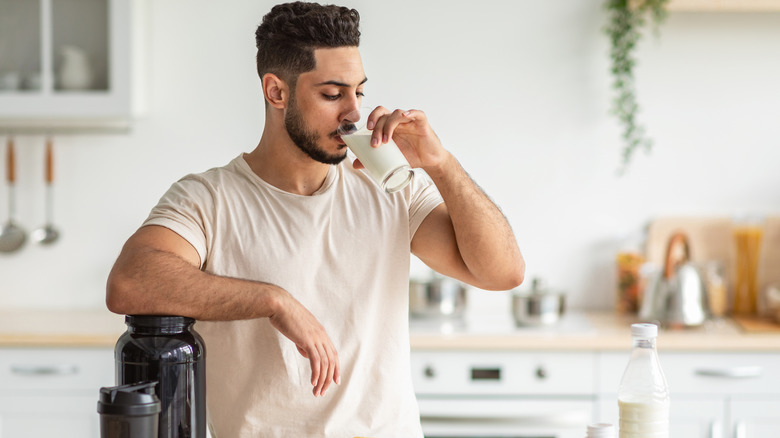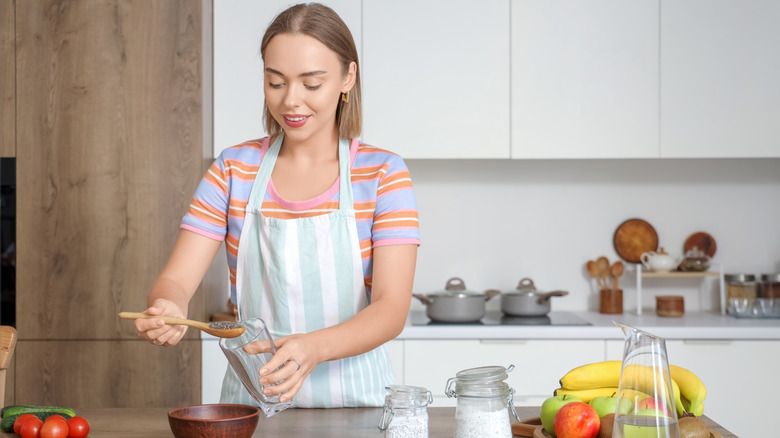The 3-Ingredient Protein Powder You Can Make At Home (But Is It Healthier Than Store-Bought?)
Protein powders are a quick and convenient way to boost your protein intake. These days, you've got way more options than back in the Arnold-era when it was all about whey. While whey is still the go-to for muscle building, some people opt for casein if they want something slower to digest, or a vegan protein made from things like peas or quinoa. You also have plenty of flavor choices beyond vanilla and chocolate.
That said, let's be real: some of these powders can be pricey. And since supplements aren't regulated by the FDA, it's hard to know exactly what you're getting (here are some of the best and worst protein powder brands). Some powders have been found to contain heavy metals and other stuff you probably don't want in your body (um, edible glitter?).
If you're looking for a cleaner alternative, you can make your own vegan protein powder at home using ingredients like hemp, chia, and pumpkin seeds. It might not pack as much protein per scoop as that giant tub of whey, but it does offer a range of other nutrients that can be great for your overall health.
The health benefits of this seed-based protein powder
This seed-based protein powder is made with a cup of chia seeds, a cup of hemp seeds, and ¼ cup of raw pumpkin seeds. A 2-tablespoon serving provides 141 calories and almost 7 grams of protein. That's just a little more protein in an egg. You'll also find that this protein powder has 7 of the 9 essential amino acids to help your body synthesize and repair muscle.
What makes this homemade protein powder so healthy is its unsaturated fats. That one serving provides 72% of your omega-3s for the day. Don't count out omega-3s as part of your strength-building stack. According to a 2023 review in Nutrients, omega-3s can help your body recover from exercise-induced inflammation and support muscle repair. The quicker the recovery, the harder you can work out later.
What you won't be missing in this vegan protein powder is sodium. Flavored whey protein powders can add about 200 milligrams of sodium, while some of your favorite vegan protein powders can have up to 430 milligrams of sodium. That's not great if you're trying to watch your blood pressure. This simple homemade version has less than a milligram of sodium yet 244 milligrams of potassium and 33% of your daily value for magnesium. Because it's flavorless, you can add this to recipes to boost the protein and healthy fats while keeping the sodium levels low.
How to make a 3-ingredient protein powder
This protein powder comes together quickly using a spice grinder or a high-powered blender with a pulse setting. To avoid making a paste by blending the seeds, pulse portions of the seeds at a time and combine them in an airtight container. Because this protein powder doesn't have any preservatives, be sure to store it in the refrigerator and use it within two weeks. It will also stay fresh in the freezer for two months.
For a little more fiber, you can substitute a cup of flax seeds for the chia seeds to give you more than 3 grams of fiber while keeping the same amount of protein. For more antioxidants and flavor, try adding raw cacao powder (about half a cup) to the mix. You can also try flavoring it with cinnamon for additional health benefits. (This is what happens when you eat cinnamon every day.)
This protein powder can be mixed into your favorite fruit smoothie. To boost the protein content, try adding half a cup of Greek yogurt for an additional 11 grams of protein. To keep it vegan, try adding half a cup of frozen peas for 3 more grams of protein and 3 grams of fiber. When adding this 3-ingredient protein powder to recipes, remember that you'll probably need to add a little more water. Chia seeds tend to soak up water, so you may notice your batter may be a little thicker.


